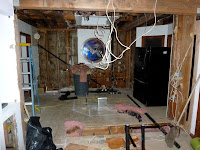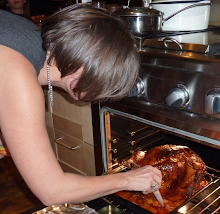I know I know. The no knead bread craze is over. But I'm hooked. I've been baking bread for a very long time, mostly with whole grains, often with sourdough, and am a total fan of Peter Reinhart's books and recipes and teachings. And for the longest time I thought the no knead breads are a fad, nobody in their right mind could want to do a bread like that. Until - until I finally tried it.
Mark Bittman said in his second blog on the topic that you can't follow the "traditional" version when you're using whole wheat. I completely disagree. This is how my whole wheat no knead bread looks like:
In my book that's a fine looking bread. Especially since this one was baked at 6,000 feet, where I had problems with all of Peter Reinhart's recipes.
And the best thing is - it's super easy to make. There is a drawback - the bread doesn't age quite as well as a properly kneaded bread, but that is just a great excuse to eat more bread! While I often use spelt, and wheat and rye in differing proportions my mainstay bread is mostly white whole wheat and a bit of rye to make it moister.
Start with 2.5 cups of white whole wheat (I haven't bought regular whole wheat since I discovered white whole wheat. It's much less gritty, and has a great flavor to it), 0.5 cups rye (I have a very coarse rye ground which I like better than the fine ground rye, but it doesn't really make a difference), shy of 1/2 teaspoon instant yeast, 2 teaspoons salt, 0.5 cups seeds or walnuts, and 1.5 to 2 cups cold water. Mix everything together for a minute or two, and adjust the water. You want a wet to sticky dough that's easy to manipulate with a cooking spoon, but not a liquid mess. When you're done shape a round ball in the middle of the bowl, and put everything in the fridge. In a pinch you can just let it rise, but the taste improves dramatically when the dough gets a slow fermentation at least overnight, up to a few days. Yes, it requires planning ahead. Doesn't all baking?


In this case, the dough spent 3 nights in the fridge. When you're ready to bake pull it out and let it come to room temperature. It should have about doubled. Ok, this one probably tripled rather than doubled. Nothing to worry about. Perhaps they should call it the "no worry bread"?
Now the only tricky part of the whole business starts - shaping. Carefully empty your bowl onto a well floured surface. You don't want to deflate it too much. Then shape it - it's a fancy name for basically just folding it over like you would a letter, in thirds, one from each side. Then do it again from the other side. It helps with surface tension of the dough and makes the bread rise like you want a bread to rise, in a nice boule, not flat like a cake, and to give you a nice, artisan looking crust.
Especially when the dough is very wet it helps to use the bench scraper for the shaping. Then the dough then rests some more, ideally an hour. I like to put mine an a banneton for the looks, but any well floured bowl will do. Put it in with the seam on the top, since that'll be the bottom of the bread.
While the dough is going through its final fermentation prepared the oven. The no knead bread gets baked in a Dutch oven. I find this method so good that I bake all my breads that have a wet dough like this - it saves you to add moisture to the oven and gives you an outstanding crust. For the 3 cup bread I either use a 2.25 quart Staub cocotte, or my Grandmother's oblong dutch oven.
Put the empty, unoiled Dutch oven with the lid in the oven and preheat to 500F or as far as your oven will go. Once it reaches the temperature wait another 15 minutes. Then take the Dutch oven out (be very very careful - 500F!), take the lid off, pour your bread dough in, and slash the surface. After experimenting with knives and razor blades I find that scissors work the best. Put the lid back on, stick the Dutch oven in the oven, lower the temperature to 475 or 450, and set a timer to 30 minutes.
After 30 minutes, remove the lid and lower the temperature to 425F. The bread already looks great, doesn't it?
At 6,000 feet, and in the oblong pan I bake it for another 30 minutes, in the round pan probably another 40 minutes. At 1,500 feet I only bake it another 20 minutes. It's also a function of what temperature your dough had when you put it in. Since I don't have a bakery, and am not always able to time things perfectly there is quite a bit of variation in it. However, there is a sure way to tell that your bread is done: The internal temperature needs to be at 210 to 220 F.
Once you take the bread out withstand the temptation to eat it right away: It needs to cool at least an hour. And this is how mine looked today:
Made for a glorious breakfast, with one of my 100 dozen eggs :-)
Recipe:
Whole Wheat No-Knead Bread
2.5 cups white whole wheat flour
0.5 cups rye
shy of 1/2 teaspoon instant yeast
0.5 cups seeds or walnuts
2 teaspoons salt
1.5 to 2 cups of water
Mix all ingredients into a sticky dough, let rest in the fridge at least overnight.
Let come back to room temperature, then shape, and bake per instructions above.
My favorite variation is to use black olives and chopped rosemary instead of the seeds. But the sky is the limit - go and play with it and let me know what your favorites are!





















































